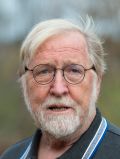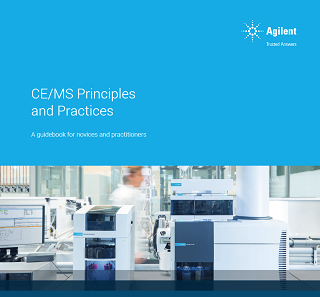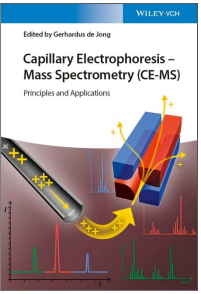My Blog Pages

You are invited to follow the latest news about my participation in conferences, symposia, events and my publications in the field of liquid phase separation science in this blog. If you have a comment or suggestion for me about a post, please feel free to use the comment function at the bottom of each post. For your convenience, I have started adding a "home" icon to each post. Just click on the icon to return to the home page.
Unfortunately, I had to turn off the mail function of this site because it was being abused. But most of you will know how to contact me anyway.
Gerard
It is my pleasure to announce the publication by Agilent Technologies of a 100-page guidebook on CE/MS. It is intended as a resource for novices and practitioners of CE/MS and has a focus  on the Agilent CE/MS product and applications.
on the Agilent CE/MS product and applications.
It is the intention of this guidebook to help novices to step into the practical application of CE/MS, and to provide current users with relevant information on method development and on diagnosis of practical problems. Towards this goal, the booklet is divided into two parts:
Part 1: Concepts of CE/MSDescription of the concept of CE/MS coupling with detailed emphasis to help understand the technique and to choose proper starting conditions. This part is my contribution.
Part 2: Practice of CE/MS Detailed description of the practice according to recommendations of Agilent that help to set up the CE instrument, the interface, the MS, and to provide current users with relevant information on method development and on the diagnosis of practical problems. Also, detailed guidelines to do system performance verification will be given. This second part is contributed by Agilent specialists mentioned on page 10 of the booklet.
Leading experts in the field of CE/MS, Dr. Julie Schappler of Geneva University and Prof. Dr. Christian Neusüß have contributed with forewords.
The booklet is highly recommended especially for those who are considering applying CE/MS in their research. A click on the cover page will allow you to access the booklet from the Agilent website.
- Details
- Hits: 6156
32nd International Symposium on Chromatography, September 23-27, 2018
At the above symposium I have participated as the chairman of the Best Poster Award Review board and have contributed with an oral presentation.
The award presentation slides are available here.
A PDF copy of my talk is available via following link. The animation on slide 8 works but needs to be started via the button. The animation op slide 13 doesnot work.
- Details
- Hits: 6932
On June 20, I was invited to contribute to the doctorate seminar for students participating in the Analytics for Biologics project at Groningen University, the Netherlands. Please review this link for more information on this project. See also the detailed agenda of the two-weeks seminar via the link to the agenda on this page.
Sixteen doctorate students from Europe participated in the whole seminar and were also present during my contribution on capillary electrophoresis.
The preparation of the CE and CE-MS course was a larger effort that I have anticipated. I was very happy to receive good help from Agilent Technologies (my former employer) especially Dr. Martin Greiner and Dr. Jens Hühner, from Dr. Julie Schappler from Geneva University, Switzerland and from Prof. Christian Neusuess from Aalen University Germany who all provided highly relevant slides. In particular I was pleased to receive 10 printed copies of the Agilent Primer on CE which has become a tool for education at many schools, colleges and universities. I am grateful to all of them.
For the students (and others) to access a PDF copy of the whole course will be through the following link. In order to access the linked menu one has to login first. Please request your account via top menu “Contact me” and login via “Registered Visitors” after you have received the account name and password.
Alternatively I can send you a private cloud link
- Details
- Hits: 8251
The 1st Joint CE- and FFE Forum was held October 5 and 6, in the Fraunhofer Institute of Chemical Technology, Pfinztal (close to Karlsruhe). I had the priviledge to be the co-organizer with Dominik Mueller who is a scientist in the ICT working in the electrochemistry group. The Forum takes place annually under global responsibility and with support of the Workgroup Separation Science of the Section Analytical Chemistry of the German Chemical Society (GDCh).
About 30 scientist, graduate and post-doctoral students attended. In principle all participants contributed with an oral or poster contribution which has stimulated intensive discussions and exchange of experience. The organizers obtained valuable suggestions for stimulation and continuation of the forum.
For full details visit the forum website.
- Details
- Hits: 18754
At the 31st International Symposium on Chromatography, I had the priviledge to arrange the reviews for the Genzo Shimadzu Best Poster Award. Together with an international board of senior peers participating in the Symposium the posters were reviewed by the following criteria:
- Novelty and originality of the work, creativity and potential for innovation
- Scope of work, technical quality of experimental design and execution of experiments
- Readability of the presentation and author’s explanations (during the poster session!)
Approx. 350 posters have been submitted for presentation at ISC2016. About 150 authors have opted to participate in the best poster award competition. After first round poster evaluation, by 16 reviewers working in pairs, 14 contributions were inivited for final round evaluation. This evaluation took place in a plenary session on Thursday, September 1 from 8:30 – 10:00 hrs, during which the nominated authors gave a flash presentation of her/his work in max. 3 to 4 slides. Fifteen reviewers in the room ranked the poster presentations and presenters which resulted in an overall rank.
- Details
- Hits: 10480
It is my pleasure to announce a new monograph on CE-MS

Detection in Capillary Electrophoresis – an Introduction
Gerhardus de Jong
Electrospray Ionization Interface Development for Capillary Electrophoresis-Mass Spectrometry
Jessica M. Risley, Caitlyn A.G. De Jong, David D.Y. ChenD
Sheath Liquids in CE-MS: Role, Parameters and Optimization
Christian W. Klampfl and Markus Himmelsbach
Recent Developments of Microchip Capillary Electrophoresis Coupled with Mass Spectrometry
Gerard Rozing
On-line Electrophoretic, Electrochromatographic, and Chromatographic Sample Concentration in CE-MS
Joselito P. Quirino
CE-MS in Drug analysis and Bioanalysis
Julie Schappler, Víctor González-Ruiz, Serge Rudaz
Intact Protein Analysis by Capillary Electrophoresis – Mass Spectrometry
Rob Haselberg and Govert W. Somsen
- Details
- Hits: 12152
The 42nd International Symposium on High Performance Liquid Phase Separations and Related Techniques took place in Geneva, June 21-25 2015. As at all recent HPLC symposia there was a Best Poster Award competition which was sponsored by Agilent Technologies. Also like in previous years, I had the privilege to organize the poster reviews and selection of awardees.
Of around 600 submitted posters approx. 300 authors have opted to participate in the Best Poster Award competition. This number had to be reduced to the 10 best, who were rewarded with the Best Poster Award certificate and a cash prize of 500 Euro.
Due to space limitations, all posters presented were divided into two groups, PSA- and PSB-series. Posters in the PSA-series were on display Monday and Tuesday; posters in the PSB-series were on display Wednesday and Thursday. There were three poster sessions every day (but for the last day Thursday). Authors were asked to be at their poster at designated sessions.
- Details
- Hits: 10103
It is my pleasure to announce my involvement with Advanced Electrophoresis Solutions as a scientific advisor.
Focused on providing cutting edge instrumentation, ampholytes and supplies, as well as superior customer support, AES recently has successfully commercialized uniques technologies and is now able to provide their customers with CIEF (Capillary isoelectric focusing) related products such as proprietary WCID (Whole Column Imaging Detection) based high performance CIEF instruments, WCID imaging cartridges (patent pending), reference materials, electrolytes and polymer solutions. AES products are the result of the extensive dedication of scientists and engineers continuously working in the fields of liquid phase separation science electrophoresis, chromatography and analytical analysis.
- Details
- Hits: 9435
September 30th I participated in the first Sciex Separations CESI-MS Users Meeting. The meeting was hosted by Ass. Prof. Yannis Francois at Strasbourg University. The meeting was organized by Drs. Stephen Lock and Jim Thorn of Sciex Separations.
CESI marks a novel combination of capillary electrophoresis (CE) and electrospray ionization (ESI) technologies to create an integrated workflow solution. The CE part consists of the former Beckman-Coulter PA800 CE System for Biologics Characterization and a choice of AB Sciex MS systems like the TripleTOF® 5600+ mass spectrometry system. The interface is based on the porous tip approach described by Moini (Anal. Chem. 2007, 79, 4241 - 4246) which has been extensively beta-tested by Beckman-Coulter (see e.g. Anal. Chem. 2010, 82, 9476–9483). With the formation of Sciex Separations, by combining the HPLC separation business of Eksigent with the CE separation business of Beckman Coulter, seamless complete offering for LC-MS and CE-MS is now commercially available by combining the best from Sciex MS portfolio e.g. AB Sciex TripleTOF® 5600+ mass spectrometry system.
More information can be found at the
- Details
- Hits: 12585
At the 30th International Symposium on Chromatography which took place September 14-18 in Salzburg, Austria I had the priviledge to chair a group of peers who volunteered to help select the best posters presented. Close to 600 posters were presented at the symposium of which 286 have opted to compete for the award. The Best Poster Award competition was sponsored by Genzo Shimadzu and consisted of eight 500€ grants. So it was my task to reduce the group of 286 to the eight best contributions. 
- Details
- Hits: 10710
I was invited to contribute to the above distinguished seminar, arranged by Thermo Fisher Scientific. The event took place at the Thermo Fisher Scientific site in Germering close to Munich, September 4 and 5. The seminar was arranged and moderated by Dr. Frank Steiner and Dr. Remco Swart. Several well known scientists were present like Prof. David McCalley, Univ. South West England, Prof. Wolfgang Lindner, Vienna University, Prof. Christian Huber from Salzburg University, Prof. Gert Desmet, Free University of Brussels, Prof. Gérard Hopfgartner from Geneva University, Prof. Peter Schoenmakers, University of Amsterdam. Presentations were delivered by David McCalley, Christian Huber, Dr. Stephan Lamotte, Dr Thorsten Teutenberg, Univ. of Duisburg, Dr. Bas Eeltink, Free University of Brussels, Dr. Chris Pohl of Thermo Scientific and myself. A PDF-copy of my talk can be found in the menu item "My Orals".
- Details
- Hits: 10782
Dear Visitor,
I have prepared a comprehensive blog on CE-MS interfacing methods. Actually the information provided is distributed over three separate blogs viz. "CE-MS, the first steps", "The triple tube IF" and "Sheathless CE-MS IF". The first blog describes how CE-MS interfacing was developed until the HP/Agilent triple tube CE-MS interface was introduced on the market. The second blog has a few articles about the triple tube interface while the third blog describes new development and gives my assessment of the current status in CE-MS interfacing.
- Details
- Hits: 13342
The 41th Symposium on High Performance Liquid Phase Separations and Related Techniques, HPLC2014, took place in the Hilton Riverside Hotel, New Orleansand from May 11-15. The symposium was attended by approx. 770 delegates. About 60-70 of these were registered as exhibitors. Accounting for invited delegates, there were about 600 paying delegates. More than 200 orals and over 450 posters were presented. Ca. 45 manufacturers exhibited besides 20 media partner. These numbers are significantly lower than at HPLC2013 in Amsterdam.
- Details
- Hits: 14441
The 30th International Symposium on MicroScale Bioseparations (MSB2014) took place in Pécs, Hungary, April 27 - May 1. The meeting was organized by Prof. Ferenc Kilár, who was the symposium chairman together with Profs. Attila Fellinger and András Guttman as co-chairmen under the auspices of the University of Pécs. The MSB symposium traditionally focuses on fundamental aspects of separations on the microscale or down to nanoscale. The scientific areas of the symposium cover the application of electrically driven, microscale separations for (bio)analytical measurements in life science research, (bio)pharmaceuticals development, forensics, toxicology, doping analyses, food safety and authenticity and keeping our environment clean and sustainable. See the symposium website for more information.
- Details
- Hits: 10176
Read more: 30th International Symposium on MicroScale Bioseparations (MSB2014)
Dear all,
It is my particular pleasure to announce that I have received the Uwe D. Neue Award in Separation Science at the 41st International Symposium on High Performance Liquid Phase Separations and Related Techniques (HPLC2014), May 11-15 in New Orleans, USA. For details about the symposium click here. This award honors a distinguished industrial scientist, preferably 15 or more years after receiving his or her doctoral degree, who has made a significant contribution to the field of separation science and continues to advance it. In addition, the awardee should be an industrial scientist, and one who was instrumental in the embodiment of technology in commercial products. The award was created in honour of the legacy of Dr. Uwe D. Neue, late scientist and Waters® Corporate Fellow and is sponsored by Waters Inc.
- Details
- Hits: 11523
From January 28 - January 31, the wellknown Hyphenation Techniques in Chromatography took place in Bruges, Belgium. Since a few years, the focus of the symposium has been expanded with Hyphenated Techniques for Sample Preparation. This were the 13th issue of HTC and the 3rd issue of HTSP. Bruges is a small town in the western part of Flanders in Belgium which is dominated by its medieval patrimonium of churches and official buildings, squares and streets. The symposium took place in Congress Centre Oud Sint-Jan which is one of those old buildings rejuvenated into a congress center. The site is very concise but allowed three parallel sessions, provided ample space for posters and an exhibition on the top level where coffee and lunch was served. Further details can be taken from the symposium website.
- Details
- Hits: 9457
